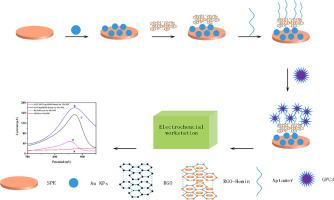Bioelectrochemistry ( IF 4.8 ) Pub Date : 2020-11-17 , DOI: 10.1016/j.bioelechem.2020.107696 Guiyin Li 1 , Huafu Feng 1 , Xiaohang Shi 1 , Min Chen 1 , Jintao Liang 1 , Zhide Zhou 1

|
Glypican-3 (GPC3) is a highly specific tumor marker for hepatocellular carcinoma (HCC), and plays an important role in reflecting the existence, therapeutic evaluation, monitoring and prognosis of HCC. Herein, an electrochemical aptasensor was designed for GPC3 detection with the reduced graphene oxide-hemin nanocomposites (RGO-Hemin) modified on the screen-printed electrode surface as the sensing platform and GPC3 aptamer as recognize molecule. In the existence of GPC3, the aptamer can specifically bind with the target GPC3 and form GPC3-aptamer conjugations on the sensing surface, which would increase the resistance of the electron transfer on the electrode and make the decrease of electrochemical signals of Hemin in RGO-Hemin nanocomposites. The electrochemical current change was recorded by differential pulse voltammetry (DPV). Scanning electron microscopy (SEM), Raman microscope (RM), cyclic voltammetry (CV) and electrochemical impedance spectroscopy (EIS) were used to characterize the GPC3 electrochemical aptasensor. Under the optimum conditions, the current response of the electrochemical aptasensor is linearly correlated with the concentration of GPC3 (0.001–10.0 μg/mL) with the detection limit of 2.86 ng/mL (S/N = 3) and the sensitivity of 0.134 μA/μM/cm2. In addition, the aptasensor was applied to the determination of GPC3 in spiked human plasma and the recoveries fluctuated from 102.68% to 117.29%. All these results show that the aptasensor has good specificity, sensitivity, stability and reproducibility for GPC3 detection.
中文翻译:

基于在丝网印刷电极表面改性的还原型氧化石墨烯-血红素纳米复合材料的Glypican-3高灵敏度电化学适体传感器
Glypican-3(GPC3)是肝细胞癌(HCC)的高度特异性肿瘤标志物,在反映HCC的存在,治疗评估,监测和预后方面起着重要作用。在本文中,设计了一种电化学适体传感器,用于GPC3检测,其中在丝网印刷电极表面修饰的还原型氧化石墨烯-血红素纳米复合物(RGO-Hemin)作为传感平台,而GPC3适体作为识别分子。在存在GPC3的情况下,适体可以与目标GPC3特异性结合,并在传感表面上形成GPC3-适体共轭,这将增加电极上电子转移的电阻,并降低RGO-中Hemin的电化学信号。血红素纳米复合材料。通过差分脉冲伏安法(DPV)记录电化学电流变化。扫描电子显微镜(SEM),拉曼显微镜(RM),循环伏安法(CV)和电化学阻抗谱(EIS)用来表征GPC3电化学适体传感器。在最佳条件下,电化学适体传感器的电流响应与GPC3的浓度(0.001–10.0μg/ mL)呈线性相关,检测极限为2.86 ng / mL(S / N = 3),灵敏度为0.134μA /μM/厘米2。另外,将适体传感器用于加标人血浆中的GPC3测定,其回收率从102.68%波动至117.29%。所有这些结果表明,适体传感器对于GPC3检测具有良好的特异性,灵敏性,稳定性和可重复性。











































 京公网安备 11010802027423号
京公网安备 11010802027423号